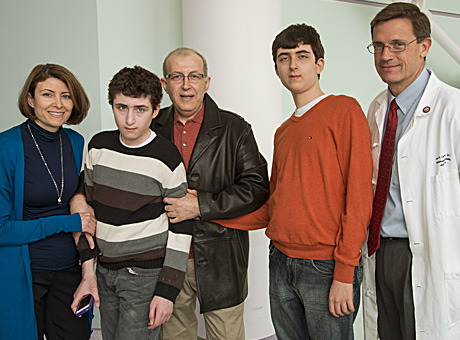
John N. Constantino, MD, far right, with the Al-joundi family, from left: Jumana, Mohamad, Bassam, and Nizar.

John N. Constantino, MD, far right, with the Al-joundi family, from left: Jumana, Mohamad, Bassam, and Nizar.
With non-identical twin teen boys, both diagnosed with autism, Bassam and Jumana Al-joundi have tried for years to find care, ongoing treatment, and hope.
“Having two children with autism is a huge responsibility to myself, God, my husband, and my boys,” says Jumana Al-joundi. “It is very challenging, but I could never imagine myself or my life without them.” Her husband, Bassam N. Al-joundi, MD, agrees. “As parents, we try anything we can to help our children,” he says. “It’s been a long struggle.”
The Al-joundis’ situation mirrors studies that show some 15 percent of families who have a child with autism have a second child with the same disorder, sparking investigation into autism’s genetic risk factors.
In groundbreaking research, Washington University psychiatrists identified subtle social deficits, language impairments, and repetitive behaviors in many unaffected siblings of children with autism. This provides important clues about how autism is transmitted in families.
“What’s equally surprising is how these traits ‘travel together’ in children without autism; they are as tightly correlated in siblings and in the general population as in the autistic syndrome itself,” says John N. Constantino, MD, the Blanche F. Ittleson Professor of Child Psychiatry and co-director of the Intellectual and Developmental Disabilities Research Center.
“Having two children with autism is a huge responsibility. It is very challenging, but I could never imagine myself or my life without them. ”
— JUMANA Al-JOUNDI
“The strong connection between these seemingly different aspects of behavior was our first clue that what goes awry in autism is an extreme version of what results in normal variation in social development,” says Constantino. “The science of autism, then, is really the study of human social behavior, where autism represents the extreme of a developmental continuum.”
Constantino and his colleagues are trying to determine why more boys than girls develop autism and how autism risk is transmitted in families, often through unaffected parents. Other Washington University researchers are conducting brain-imaging studies on infants at risk for developing autism to see if early signs of the disease can be pinpointed.
“This city needs a comprehensive autism center and coordinated resources to help families like ours over the long term,” says Bassam Al-joundi. “Research is important, but the added emphasis that Washington University will put on treatments and care for autistic children is vital.”